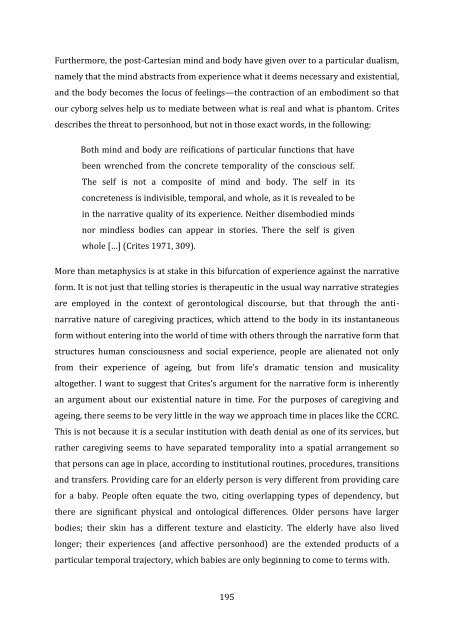Philip Y. Kao PhD thesis - Research@StAndrews:FullText
Philip Y. Kao PhD thesis - Research@StAndrews:FullText
Philip Y. Kao PhD thesis - Research@StAndrews:FullText
You also want an ePaper? Increase the reach of your titles
YUMPU automatically turns print PDFs into web optimized ePapers that Google loves.
Furthermore, the post-Cartesian mind and body have given over to a particular dualism,<br />
namely that the mind abstracts from experience what it deems necessary and existential,<br />
and the body becomes the locus of feelings—the contraction of an embodiment so that<br />
our cyborg selves help us to mediate between what is real and what is phantom. Crites<br />
describes the threat to personhood, but not in those exact words, in the following:<br />
Both mind and body are reifications of particular functions that have<br />
been wrenched from the concrete temporality of the conscious self.<br />
The self is not a composite of mind and body. The self in its<br />
concreteness is indivisible, temporal, and whole, as it is revealed to be<br />
in the narrative quality of its experience. Neither disembodied minds<br />
nor mindless bodies can appear in stories. There the self is given<br />
whole […] (Crites 1971, 309).<br />
More than metaphysics is at stake in this bifurcation of experience against the narrative<br />
form. It is not just that telling stories is therapeutic in the usual way narrative strategies<br />
are employed in the context of gerontological discourse, but that through the antinarrative<br />
nature of caregiving practices, which attend to the body in its instantaneous<br />
form without entering into the world of time with others through the narrative form that<br />
structures human consciousness and social experience, people are alienated not only<br />
from their experience of ageing, but from life’s dramatic tension and musicality<br />
altogether. I want to suggest that Crites’s argument for the narrative form is inherently<br />
an argument about our existential nature in time. For the purposes of caregiving and<br />
ageing, there seems to be very little in the way we approach time in places like the CCRC.<br />
This is not because it is a secular institution with death denial as one of its services, but<br />
rather caregiving seems to have separated temporality into a spatial arrangement so<br />
that persons can age in place, according to institutional routines, procedures, transitions<br />
and transfers. Providing care for an elderly person is very different from providing care<br />
for a baby. People often equate the two, citing overlapping types of dependency, but<br />
there are significant physical and ontological differences. Older persons have larger<br />
bodies; their skin has a different texture and elasticity. The elderly have also lived<br />
longer; their experiences (and affective personhood) are the extended products of a<br />
particular temporal trajectory, which babies are only beginning to come to terms with.<br />
195
















